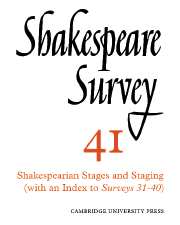Book contents
- Frontmatter
- The Shakespearian Stages, Forty Years On
- The Original Staging of The First Part of the Contention (1594)
- Charles Calvert’s Henry V
- Hamlet, An Apology for Actors, and The Sign of the Globe
- ‘Hid indeed within the centre’: The Hall/Finney Hamlet
- Malvolio and the Dark House
- The Text of Cressida and Every Ticklish Reader: Troilus and Cressida, The Greek Camp Scene
- Antony and Cleopatra, Act 4 Scene 16: ‘A Heavy Sight’
- The Tempest’s Tempest at Blackfriars
- Keats and Lucrece
- The Resources of Characterization in Othello
- Ovid and the Mature Tragedies: Metamorphosis in Othello and King Lear
- The Passing of King Lear
- Shakespeare Performances in London and Stratford-upon-Avon, 1986–7
- Professional Shakespeare Productions in the British Isles, January–December 1986
- The Year's Contributions to Shakespeare Studies: 1 Critical Studies
- 2 Shakespeare’s Life, Times, and Stage
- 3 Editions and Textual Studies
- Books Received
- Index to Volume 41
- General Index to Volumes 31-40
Hamlet, An Apology for Actors, and The Sign of the Globe
Published online by Cambridge University Press: 28 March 2007
- Frontmatter
- The Shakespearian Stages, Forty Years On
- The Original Staging of The First Part of the Contention (1594)
- Charles Calvert’s Henry V
- Hamlet, An Apology for Actors, and The Sign of the Globe
- ‘Hid indeed within the centre’: The Hall/Finney Hamlet
- Malvolio and the Dark House
- The Text of Cressida and Every Ticklish Reader: Troilus and Cressida, The Greek Camp Scene
- Antony and Cleopatra, Act 4 Scene 16: ‘A Heavy Sight’
- The Tempest’s Tempest at Blackfriars
- Keats and Lucrece
- The Resources of Characterization in Othello
- Ovid and the Mature Tragedies: Metamorphosis in Othello and King Lear
- The Passing of King Lear
- Shakespeare Performances in London and Stratford-upon-Avon, 1986–7
- Professional Shakespeare Productions in the British Isles, January–December 1986
- The Year's Contributions to Shakespeare Studies: 1 Critical Studies
- 2 Shakespeare’s Life, Times, and Stage
- 3 Editions and Textual Studies
- Books Received
- Index to Volume 41
- General Index to Volumes 31-40
Summary
The question of whether the first (1599) Globe theatre had a sign, and if so what it showed, is one that has teased scholars for some time. Sir Edmund Chambers set a tone of scepticism when he concluded his account of the Globe with the comments: ‘Malone conjectured that the name “Globe” was taken from the sign, “which was a figure of Hercules supporting the Globe, under which was written Totus mundus agit histrionem”. I do not know where he got this information.’ Ernest Schanzer demonstrated that Malone in fact got his information from the great Shakespearian scholar, George Steevens, who in turn possibly got it from the antiquarian William Oldys (1696–1761), which does not establish it as fact but at least takes it out of the realm of pure conjecture, where Chambers seemed to imply that it belonged. We do know that other contemporary playhouses boasted such signs. Johannes de Witt noted in 1596 that the two ‘more magnificent’ of the four theatres he saw around London were sited south of the Thames ‘and from the signs suspended before them are called the Rose and the Swan’.
- Type
- Chapter
- Information
- Shakespeare Survey , pp. 35 - 44Publisher: Cambridge University PressPrint publication year: 1989
- 1
- Cited by

